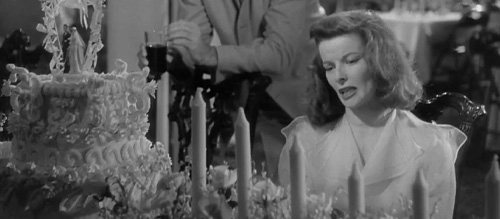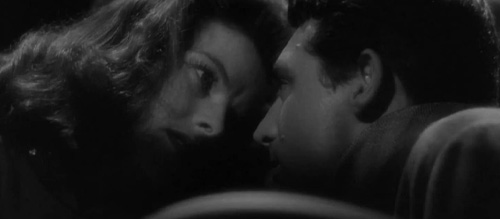A Career-Saving Change: Katharine Hepburn’s Natural Performance in ‘The Philadelphia Story’

In “Acting for the Camera“, Tony Barr defines acting as “[the response] to stimuli in imaginary circumstances in an imaginative, dynamic manner that is stylistically true to time and place, so as to communicate ideas and emotions to an audience.” (17) The “dynamic manner” is of particular importance in this definition, as a performance must feature range and change even within individual scenes to better represent the ever-changing feelings within a real person. In his essay “Notes on Film Acting“, actor Hume Cronyn also highlights the importance of change as an important part of film acting due to its effects on the audience and the practicalities of the movie business that require actors to embody disparate parts of the film to accommodate the production schedule. (199) In The Philadelphia Story, Katharine Hepburn embodies the acting principle of change, delivering a multifaceted performance that feels true to her character and keeps audience members engaged with the small-scale character drama.
The Philadelphia Story follows a socialite, Tracy (Hepburn), who is to be wed to a clumsy, self-made man (John Howard). The lead-up to the wedding is interrupted by a writer, Mike (James Stewart), and Tracy’s ex-husband, Dexter (Cary Grant), who attempt to stir up trouble on the behalf of a magazine editor. Over the course of the film, Mike and Dexter fall in love with Tracy, leading all three characters on a journey of self-discovery. Tracy occupies the most scenes as the lead character. Her various discussions with Mike and Dexter help to show the vulnerability of Hepburn’s portrayal of a tough exterior. Tracy is a woman who feels the social pressures of being a pillar for her dysfunctional family, a figure of interest in Philadelphia, and a woman who just wants to be loved for who she is. This is where Hepburn’s talent as a Hollywood Naturalist performer comes in. Within the hectic schedule of Golden Age Hollywood production and high expectations of a lead actress, Katharine Hepburn seems to effortlessly embody each nuance of Tracy in a variety of scenes with several performers.
Hume Cronyn and Bette Davis have each described what acting was like during the Golden Age, giving insight into the Naturalist approach, even if they do not refer to it as such. Cronyn, when discussing the filming of Alfred Hitchcock’s Shadow of a Doubt, mentions the complete lack of rehearsal. “My first scene was quite a long and important one,” Cronyn said, “I grew nervous and depressed in anticipation of that moment when … someone would say to me ‘You’re on!’ and I would be totally unprepared.” (193) To compensate for this, Cronyn had to rehearse on his own, creating places and things that were his character’s outside of the film’s text. While Cronyn did not live the experience of his part, he created natural aspects of the imaginary figure that would help him feel a bit more immersed into the role. Davis went into depth regarding the role of an actress in Golden Age Hollywood, both how she and the studios put actresses into parts. She was selective with roles, maxing out at four a year due to the fast pace of production, and a “refusal to disappoint her audiences by letting them see her in a role wholly unsuited to her talents…” (179) Davis, like Cronyn, used the material available to learn all she could about her characters, spending “endless hours … reading about them, studying their lives and habits…” (180) At the time of the filming of The Philadelphia Story, Katharine Hepburn’s star was on a bit of a downturn in Hollywood. She financially invested in the drama, and it paid off, literally. She successfully embodied the figure of Tracy, presumably using the techniques described by Davis and Cronyn, to create an internal reality brought to the exterior in her excellent performance.
Hepburn’s layered portrayal of Tracy can be seen early on in the film when Tracy goes with her sister to a stable where they meet her Uncle Willie (Roland Young) and fiancé George. She begins the scene with a sort of joke on Uncle Willie. Tracy pours her uncle’s favorite perfume onto a handkerchief and sneaks up behind him, causing the womanizing Uncle Willie to attempt to kiss the presumably beautiful woman who is approaching him. Hepburn’s physicality sells the weird joke. She creeps slowly towards Uncle Willie, waving the handkerchief with a wide grin across her face. He responds to this jape by pinching Tracy, who leaps away before stealing Willie’s copy of Spy magazine, a trashy tabloid that Mike writes for. Tracy sighs and switches to a more serious mood as she conveys her distaste for the magazine. When George arrives, Tracy puts on another playful front – she even tackles him to dirty his new pants. The two begin to discuss Spy and, again, Hepburn brings Tracy’s displeasure to the forefront in tone and expression. Tracy’s true feelings about George are betrayed as she refers to their future home as her own, and her demeanor changes from self-righteous sternness to placative. Every one of these mood transitions, which offer a wide look into Tracy’s feelings and relationships, is in response to listening to her own emotions and the emotions of those around her. Each emotion is accompanied by a unique physical response, both in body and tone. The grinning approach of Uncle Willie, the yanking of the magazine from his hands, her blank expressions as she reads it, the joy and playfulness with George, and her forced smile and touching of George as she tries to maintain the façade of a loving connection. Each of these actions gives us a physical window into Tracy’s soul, and gives the impression of a full, living person in an inside-out manner that feels natural.

A similar series of changes within a scene comes later when Tracy and Dexter share an exchange dripping with contempt. Tracy is confrontational from the moment Dexter walks into the scene. Her hands are on her hips before she transitions to a cross-armed pose, displaying her guarded nature that Dexter addresses in the scene. She is described as a goddess that desperately protects herself from vulnerability, and, in that moment, Hepburn begins to hold back tears, lip quivering, due to Dexter’s harsh analysis. Hepburn’s action demonstrates the truth of Dexter’s words, and it’s a brilliant and noticeable reaction that contrasts with the tough exterior she takes in the previous conversation. Tracy recovers quickly as George walks into the room, reproducing the appearance of all being well within Tracy’s spirit even when she is clearly not okay. It’s a different side to Tracy from the previous scene because Hepburn is playing the emotions that her actions are intending to cover, building on Tracy’s complex self with a new layer. Tracy herself is acting as anyone in the world would when attempting to not betray their true feelings within a situation.
One may come away from the previous confrontation wondering how Tracy and Dexter were ever married, but a later scene shows a softer side to their relationship that gives the couple a whole new context. Mike and Tracy end up at Dexter’s home following a drunken encounter with George, and Dexter goes out to meet Tracy in her car. Tracy is sleeping when Dexter slides into the seat and tells her she’s beautiful. She tells him she’s sober, but her voice is tired, her reactions delayed, and her words are slurred compared to her usual sharp intonation. This moment is fleeting, but there’s clearly a tenderness between Tracy and Dexter as they sit face to face. For a moment, one wonders if the two might kiss before she turns away, as if to avoid betraying the scent of alcohol on her breath. Hepburn’s portrayal offers more of the concealed vulnerability, yet she continues to play the attempts at guarding it, something much more difficult to do for a character under the influence of alcohol.
Katharine Hepburn’s acting ability within the Hollywood Natural style allows her to excel in the role of Tracy in The Philadelphia Story. The wide variety of scenes and interactions at varying levels of emotionality and sobriety give her an opportunity to showcase many emotions, and actions that help convey or cover them. She does not only listen to words, but also layers of feelings about the other characters, the situations Tracy is involved in, and responses to physical stimuli. The result is an incredibly complex character that exemplifies the idea of a dynamic performance while managing to seem real to each of us. It’s no wonder that this role got her career back on track after critical failures and a falling out with MGM.
Bibliography
Barr, Tony. Acting for the Camera. Revised Edition, Eric Stephan Kline, William Morrow, 1997, New York.
Cronyn, Hume. “Notes on Film Acting.” Theory and Practice of Acting, printed by Richard Allen, 13 Feb. 2023. 193-200.

